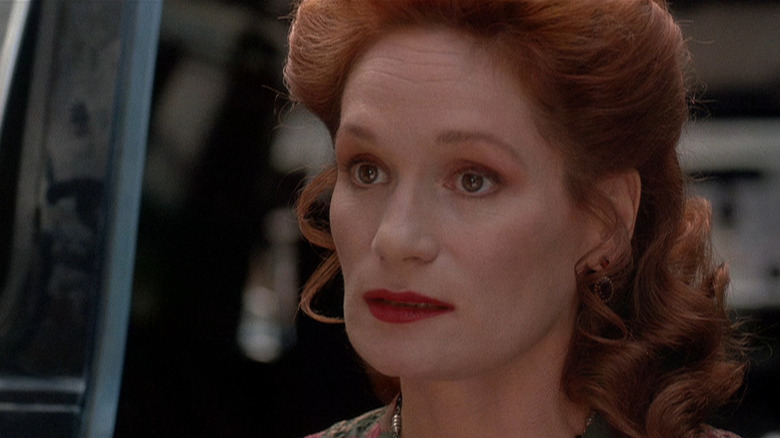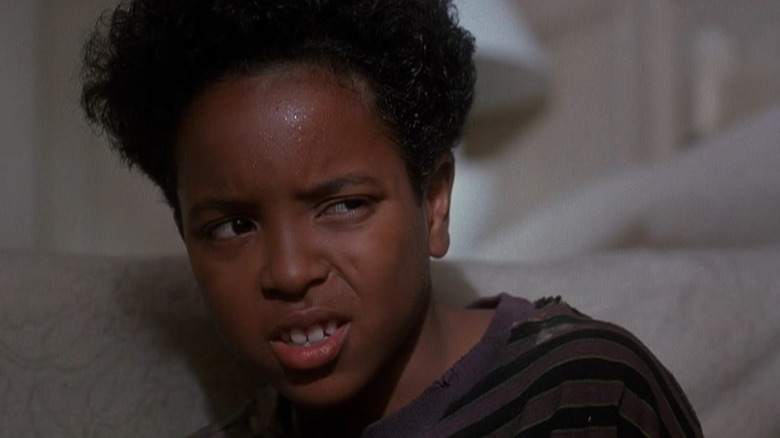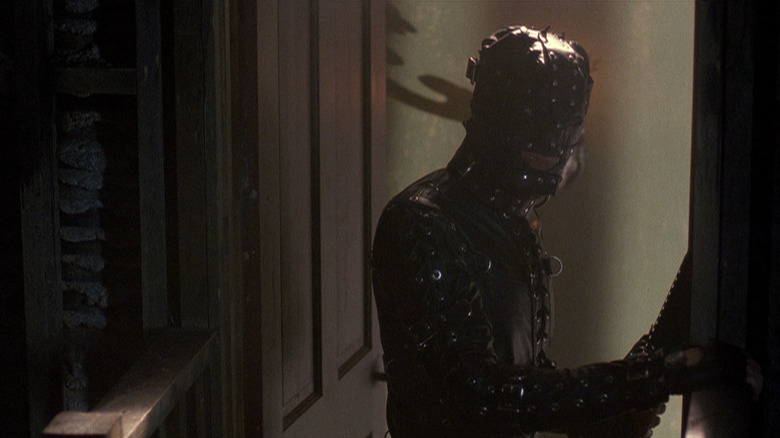Wes Craven Feared This Cult Classic Horror Film Was Destined To Get An NC-17 Rating
Wes Craven's 1991 horror film "The People Under the Stairs" is as politically poignant as it is bleakly terrifying. The movie centers on "Fool" Williams (Brandon Adams), a young boy whose family faces eviction at the hands of the wealthy white landlords that own his building. The landlords are the Robesons (Everett McGill and Wendy Robie), and they have an all-too-common scheme to raise rents, evict un-paying tenants, and then sell their buildings to major corporations for big money. To combat this, Fool and his friend Leroy (Ving Rhames) break into the Robesons' house, hoping to rob them and achieve some form of justice.
What Leroy and Fool find in the Robesons' house, however, is chilling and evil. It seems the Robesons are horrid taskmasters and serial kidnappers who have locked many children in their basement under the stairs. Their "children" have, after many years underground, developed into mute, pale cannibals. One child, Alice (A.J. Langer), remains aboveground, and she only escapes the cannibalistic prison by never speaking in front of the Robesons and doing exactly what they say. "The People Under the Stairs" is a terrifying escape picture, following Fool as he attempts to keep cool and flee this hellish home. It's also clearly a tale of class and exploitation, with the Robesons standing in for exploitative racist slumlords everywhere.
The film's violence is hard-edged and plentiful. It's not a fun, whimsical horror movie, but a sweaty, explicit panic attack. Because of this, it almost got an NC-17 rating when it was first submitted to the MPAA (now the MPA). That rating was relatively new at the time, and Craven didn't know what commercial or social implications it would invite from the public. Luckily, the director was able to make one small cut — a scene of cannibalism — and retain the R rating he wanted.
Wes Craven only had to make one cut to get The People Under the Stairs an R rating
One might recall that the NC-17 rating was invented in 1990 to replace the X rating from previous decades. The MPAA never placed a copyright on the phrase "X-Rated," and it was co-opted by the porn industry. Indeed, it was so pervasively used on porn that "X-rated" or "XXX-rated" now refers to any hardcore pornographic movies or photographs. When the NC-17 was invented, Craven was concerned how it would be perceived by the public. He feared that previously R-rated films (which most of his movies were) would be judged more harshly thereafter and given an audience-unfriendly NC-17 instead.
When Craven submitted "The People Under the Stairs" to the MPAA for review, it did indeed come back with an NC-17 rating. It was, it seems, just too bleak and violence for the ratings board. Surprisingly, Craven only had to make a single cut to land a more commercially viable R rating. Craven was grateful, but the whole process is a headache for any creative person. He expressed his frustrations to Cinefantastique Magazine in 1992 by citing William Sergeant's book "Battle for the Mind," which details the demoralizing effect suffered by soldiers in POW camps. "One moment they'll be praised," he explained, "the next, they'll be hit over the head with a stick." He continued:
"I feel the same way abut the MPAA. I went in with a film about underage children in terrifying situations, dealing with child abuse and implied sexual abuse. Although we tried very hard to treat the subject reasonably, I still feel that I could easily get into trouble in a half-dozen scenes. Instead, with one cut in one scene, we were given an R. I don't understand it, but I celebrate it, because it would have been painful to cut into the rest of it."
The scene in question was mere seconds of footage.
Wes Craven had to cut a cannibalism scene from The People Under the Stairs
Cinefantastique reported that the deleted scene was a very brief shot of the McGill character, nicknamed "Daddy," eating a human liver. It came when Daddy had apprehended a victim and sliced open their midsection with a blade. He removed the liver and tossed it to his "children" under the stairs. In the longer cut, Daddy took a brief nibble of the liver himself before flinging it to the kids. The liver was an effect constructed by special effects guru Greg Nicotero. It was painful to cut the scene after so much effort had been made to construct a fake human liver, but it seems the MPAA preferred "The People Under the Stairs" without it.
Craven felt that the MPAA often reacts to the function and dramatic power of violence, and he hoped that "The People Under the Stairs" was a strong enough work of art that he would be permitted to include the level of violence and horror that he wanted. As he put it:
"I've noticed on some of my films that, if the film has a universal enough appeal, it will move even the ratings board, and they'll take the attitude [of] 'Just cut this one thing; the film is so good that it doesn't need this, but we can understand what you're doing.' That seemed to be the cast with 'The People Under the Stairs.'"
Craven added that "The People Under the Stairs" is not an exploitation movie; rather, it addresses important concerns. It's about the way adults oppress and abuse children (a subject close to Craven), but also racism and the economic realities of poverty, and it's all handled with tact and seriousness. "In many ways, it's quite terrifying, over-the-top, and appalling. In other ways it's a very positive social statement," he remarked. Indeed, there's a reason it's regarded as one of Craven's best movies.


